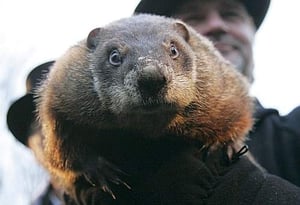 Have you made plans for the weekend of February 1st? If not, there’s still time to get your tickets for the Annual Groundhog Club Banquet in Punxsutawney, PA. Once again, following the banquet, on the morning of February 2nd, 30,000 people will make the trek to Gobbler’s Knob to witness the Seer of Seers, Punxsutawney Phil, make his annual prediction about the weather.
Have you made plans for the weekend of February 1st? If not, there’s still time to get your tickets for the Annual Groundhog Club Banquet in Punxsutawney, PA. Once again, following the banquet, on the morning of February 2nd, 30,000 people will make the trek to Gobbler’s Knob to witness the Seer of Seers, Punxsutawney Phil, make his annual prediction about the weather.
Punxsutawney Phil won’t be alone in this endeavor. Other notable Sciuridae weathermen around the country, including Sir Walter Wally in North Carolina, General Beauregard Lee in Georgia and Flatiron Freddy right here in Colorado (Freddy is actually a marmot since CO doesn’t actually have any groundhogs) will also try their paw at predicting the weather.
But here’s the question, do groundhogs actually have any proclivity for predicting the arrival of spring? The answer is actually more complicated than you might imagine. To begin with, the tradition of Groundhog Day, which by the way falls exactly in between the winter solstice and the spring equinox, didn’t initially involve Groundhogs at all. Rather, this tradition, which began in Europe and is tied to two much earlier festivals, Candlemas and Imbolc, began with people looking for shadows. A poem that predates Groundhog Day by several hundred years gives us some insight into the origins of this unorthodox method of weather prediction:
If Candlemas (which is also celebrated on February 2nd) be fair and bright,
Winter has another flight.
If Candlemas brings clouds and rain,
Winter will not come again.
It was only later that Germans added that element of an animal. They believed that if an animal saw its shadow on Candlemas that it would be scared back into it’s den (indicating more wintry weather to come). Since there are no groundhogs in Europe, the tradition was started with Hedgehogs (which incidentally are not related to Groundhogs). When German immigrants settled in Pennsylvania in the 18th century, they brought this weather lore with them. But it was at this point that the Groundhog, prevalent in central Pennsylvania, replaced the Hedgehog.
So back to our question, do Groundhogs have any business competing with NOAA (National Oceanic and Atmospheric Administration) meteorologists in predicting the weather? Let’s take a look at the facts.
The people in Punxsutawney claim that they do not decide Phil’s prediction in advance but rather communicate with him at dawn on the morning of Feb 2nd to determine whether he has seen his shadow. Between 1887 and 2012, the Punxsutawney Groundhog Club reports that Phil has seen his shadow (more winter to come) 100 times to only 16 times that he has not seen a shadow (spring on the way). This makes sense considering that the actual end of winter is not until 6 weeks later, on March 19th.
The folks at the National Climatic Data Center analyzed US national temperatures vs. Phil’s prediction for the years 1988-2012 and this is what they found:
- Phil saw his shadow (which indicates 6 more weeks of winter) 18 of the 25 years analyzed. This translates to 72% of the time. Again, considering that winter does not end officially until 6 weeks after the Holiday, you’d think this would give him a sporting chance.
- In the 18 years that Phil saw his shadow (supposedly indicating 6 more weeks of winter), February temperatures were at or below normal only 6 of the years or 33% of the time. Again, one would think that this percentage should be higher considering Phil’s prediction of more winter to come.
- In the 7 years that Phil did not see his shadow (supposedly indicating the end of winter), February temperatures were above normal 4 of the years or 57% of the time. So Phil did a little better on this front but still ends up with an overall accuracy rate of around 39%.
So how do the folks at NOAA stack up? David Unger, a meteorologist with the National Weather Service, estimates that modern climatological predictions about the mildness or severity of the remaining winter are accurate about 60% of the time (significantly higher than Phil’s rate of 39%). So it appears that the folks at NOAA are not in danger of being replaced by a Corp of Groundhogs anytime soon. Still, I think I’d enjoy the Annual Groundhog Banquet more than I would a similar gathering of climatologists.
If you’d like to check out Phil’s prediction this year, just go to the Punxsutawney Groundhog Club website on February 2nd and decide for yourself whether you’ll get your future predictions from Phil or NOAA.
Author, Doug Dusenberry, is the Director of Major and Planned Giving at walking Mountains Science Center, where you can learn a lot more about weather and climate. If you’d like to find out more, just visit us online at www.walkingmountains.org, or stop in to our campus in Avon.









